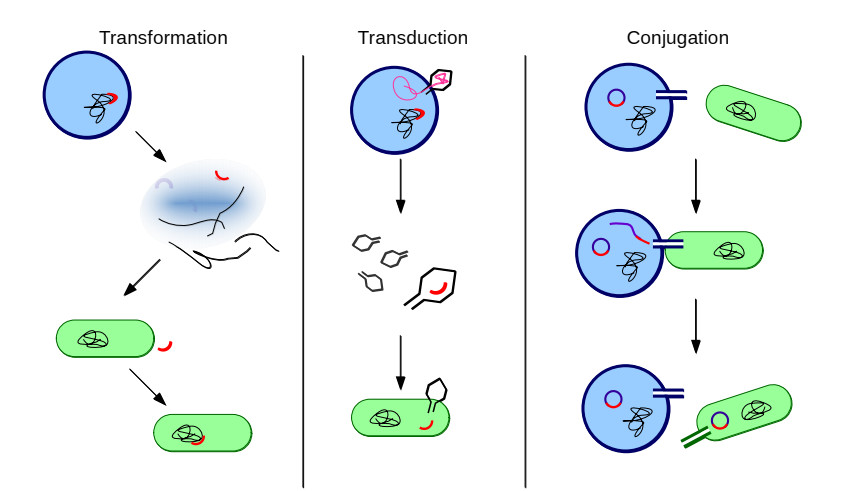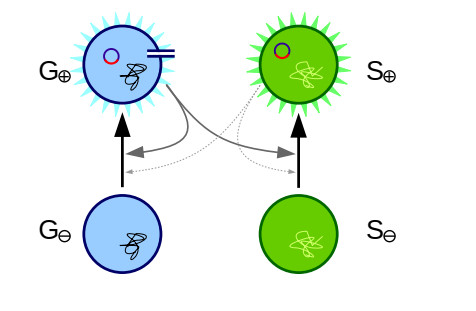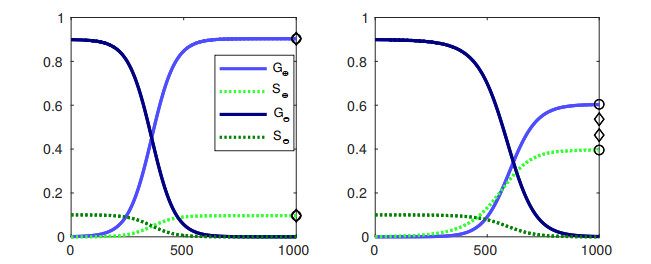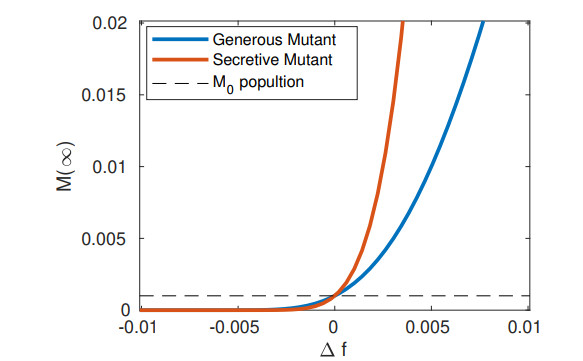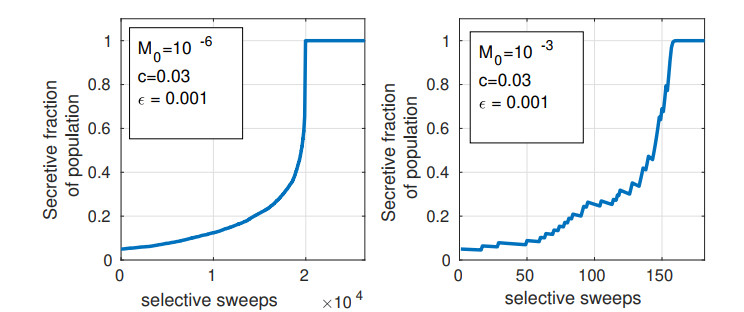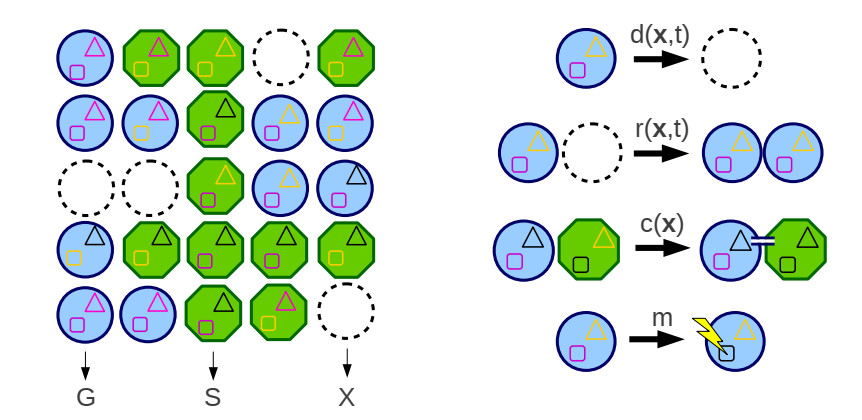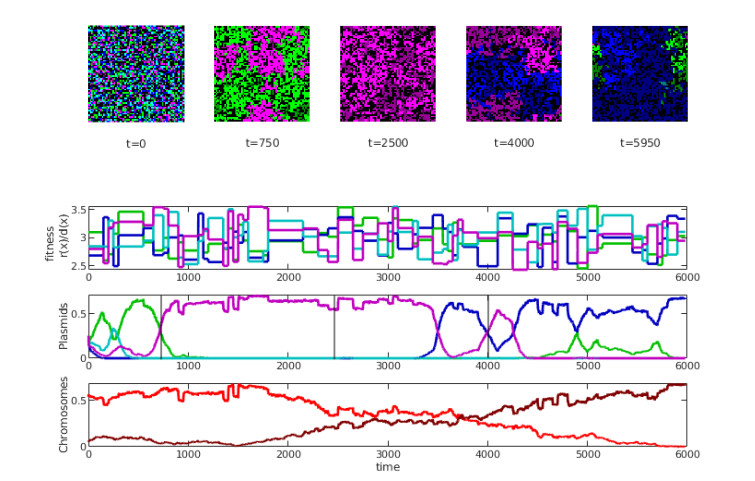1.
Introduction
Many complicated structures' memory and natural features may be realized using fractional calculus (FC), which studies integrals and derivatives of fractional orders [1,2]. Many recent FC applications have included analyzing the dynamics of large-scale physical events by converting derivatives and integrals from classical to non-integer order. Many branches of engineering and the physical sciences use it, including electric circuits, mathematical biology, control theory, robotics, viscoelasticity, flow models, relaxation, and signal processing [3,4]. Numerous mysterious ideas have been refined via the study of fractional calculus, for example, logistic regression, Malthusian growth, and blood alcohol concentration, all of which have shown that fractional operators outperform integer-order operators [5,6].
Derivatives of fractional order such as Riemann-Liouville, Atangana Baleanu, Caputo, Hilfer, Grunwald-Letnikov, Caputo Fabrizio, and Riemann-Liouville are among the numerous that have recently been proposed [7,8]. Since all fractional derivatives may be reduced in Caputo's meaning with minor parametric adjustments, the fractional derivative of Caputo is the essential principle of FC to investigate fractional differential equations (FDEs). Caputo's operator, which has numerous applications to model various physical models, possesses a power-law kernel. To address this difficulty, the alternative fractional differential operator [9] was developed, which consists of a Mittag-Leffler kernel and an exponentially decaying kernel. Caputo-Fabrizio (CF) and Atangana-Baleanu are operators characterized by their non-singular kernels. These operators have been widely applied in analyzing diverse problem classes, including but not limited to biology, economics, geophysics, and bioengineering [10].
Korteweg and de Vries introduced the KdV equation in 1895 to formulate a model for Russell's soliton phenomenon, encompassing water waves of long and small amplitude. Solitons are classified as stable solitary waves, signifying their particle-like nature [11]. Various applied disciplines, including plasma physics, fluid dynamics, quantum mechanics, and optics, implement the KdV equations [12]. Particle physics has employed the fifth-order KdV equations to analyze many nonlinear phenomena [13]. Its function in the propagation of waves is crucial [14]. The authors find third-order and fifth-order dispersive terms in the KdV form equation pertinent to the magneto-acoustic wave problem. Furthermore, these dispersive terms manifest themselves in the vicinity of critical angle propagation [15]. An electrically conducting fluid, plasma is also dynamic and quasi-neutral. Ions, electrons, and neutral particles comprise it. Due to the electrical conductivity exhibited by plasma, it includes both electric and magnetic regions. The variety of particles and regions supports diverse types of plasma waves. A magnetic lock is a less longitudinal ion dispersion. In the low magnetic field range, the magneto-acoustic wave exhibits characteristics of an ion acoustic wave [16,17]. However, at low temperatures, it transforms into an Alfven wave.
Equivalent to the general model for the investigation of magnetic characteristics of acoustic waves with surface tension is the fifth order of KdV. According to a recent investigation [18,19], the solutions to the equation above concerning traveling waves persist beyond infinity. The following are two widely recognized types of fifth-order KdV equations [20,21]:
Here, Eqs (1.1) and (1.2) are called the Kawahara and KdV equation of fifth-order, respectively. The extreme nonlinearity of these mathematical models makes it difficult to find suitable analytical methods. Researchers have developed and implemented several techniques for solving nonlinear and linear equations of KdV in the past ten years. These techniques include the variational iteration method [21], the multi-symplectic method [22], He's homotopy perturbation method [23], and the Exp-function method [24].
Omar Abu Arqub established residual power series method (RPSM) in 2013 [25]. It is created by merging the residual error function with the Taylor series. According to [26], an infinite convergence series solves differential equations (DEs). The development of novel RPSM algorithms has been prompted by several DEs, including KdV Burger's equation, fuzzy DEs, Boussinesq DEs, and numerous others [27,28]. The goal of these algorithms is to provide efficient and accurate estimates.
A novel strategy for solving FDEs was established by integrating two effective methods. Some approaches that fall into these categories include those that use the natural transform [29], the Laplace transform with RPSM [30], and the homotopy perturbation method [31]. In this work, we used a novel combination method known as the Abdooh residual power series method (ARPSM) to discover approximation and precise solutions for time-fractional nonlinear partial differential equations (PDEs). This innovative method is significant because it combines the Aboodh transform technique with the RPSM [32,33].
The computing effort and complexity needed are significant issues with the previously mentioned approaches. Our suggested Aboodh transform iterative method (ATIM) [34] is this work's unique aspect that solves the Kawahara and KdV equations of fractional order. By integrating the Aboodh transform with the new iterative technique, this strategy significantly reduces the computing effort and complexity required. According to [35,36], the suggested approach yields a convergent series solution.
The ARPSM and the ATIM are the two most straightforward approaches to solving fractional DEs. These methods fully and immediately explain the symbolic terms used in analytical solutions and offer numerical solutions to PDEs. This paper assesses ATIM and ARPSM's efficacy in solving the fifth-order KdV and Kawahara equations.
The fifth-order KdV and Kawahara equations are solved using ARPSM and ATIM. These methods provide more precise numerical answers when compared with other numerical techniques. Additionally, a comparison analysis is performed on the numerical findings. The suggested approaches' findings are consistent with one another, which is a strong indicator of their efficacy and reliability. For various values of fractional-order derivatives, there is additional graphical importance. Therefore, the methods are accurate, easy to implement, not affected by computational error phases, and quick. This study lays the groundwork for researchers to quickly solve various PDEs.
2.
Basics of fractional calculus
Definition 2.1. [37] Assume that η(ϵ,Ω) is an exponential order continuous function. The definition of the Aboodh transform (AT), assuming σ≥0 for η(ϵ,Ω), is as follows:
The Aboodh inverse transform (AIT) is given as:
where ϵ=(ϵ1,ϵ2,⋯,ϵp)∈Rp and p∈N.
Lemma 2.1. [38,39] It is assumed that there exist two exponentially ordered, piecewise continuous functions η1(ϵ,Ω) and η2(ϵ,Ω) on [0,∞]. Let A[η1(ϵ,Ω)]=Ψ1(ϵ,Ω),A[η2(ϵ,Ω)]=Ψ2(ϵ,Ω), and χ1,χ2 be arbitrary constants. These characteristics are thus true:
(1) A[χ1η1(ϵ,Ω)+χ2η2(ϵ,Ω)]=χ1Ψ1(ϵ,ξ)+χ2Ψ2(ϵ,Ω),
(2) A−1[χ1Ψ1(ϵ,Ω)+χ2Ψ2(ϵ,Ω)]=χ1η1(ϵ,ξ)+χ2η2(ϵ,Ω),
(3) A[JpΩη(ϵ,Ω)]=Ψ(ϵ,ξ)ξp,
(4) A[DpΩη(ϵ,Ω)]=ξpΨ(ϵ,ξ)−∑r−1K=0ηK(ϵ,0)ξK−p+2,r−1<p≤r, r∈N.
Definition 2.2. [40] In terms of order p, the function η(ϵ,Ω) has derivative of fractional order as stated by Caputo.
where ϵ=(ϵ1,ϵ2,⋯,ϵp)∈Rp and p,m∈R,Jm−pΩ is the integral of the Riemann-Liouville of η(ϵ,Ω).
Definition 2.3. [41] The representation of power series is composed of the following structure.
where ϵ=(ϵ1,ϵ2,⋯,ϵp)∈Rp and p∈N. This is known as the multiple fractional power series concerning Ω0, where Ω and ℏr(ϵ)′s are variable and series coefficients, respectively.
Lemma 2.2. Consider the exponential order function is denoted as η(ϵ,Ω). A[η(ϵ,Ω)]=Ψ(ϵ,ξ) is the description of the AT in this case. Hence,
where ϵ=(ϵ1,ϵ2,⋯,ϵp)∈Rp and p∈N and DrpΩ=DpΩ.DpΩ.⋯.DpΩ(r−times)
Proof. By using the induction method, we have to prove Eq (2.1). In Eq (2.1), substitute r=1.
On the bases of Lemma 2.1, Eq (2.1) for r=1 holds true. Put r=2 in Eq (2.1).
From left-hand side (LHS) of Eq (2.2), we obtain:
The expressions for Eq (2.3) are as follows:
Assume
This makes Eq (2.4) as
From the definition of the derivative of Caputo, we make changes in Eq (2.6).
By applying the Riemann-Liouville integral Eq (2.7), we obtain:
By using the AT feature of differentiability, Eq (2.8) is modified:
From Eq (2.5), we derive:
where A[z(ϵ,Ω)]=Z(ϵ,ξ). Hence, Eq (2.9) becomes
Let's suppose Eq (2.1) holds true for r=K. Substitute r=K in Eq (2.1):
Substituting r=K+1 in Eq (2.1):
After analyzing Eq (2.12)'s LHS, we deduce
Let
By Eq (2.13), we drive
By using the integral of the Riemann-Liouville and derivative of Caputo on Eq (2.14), the subsequent result can be obtained.
To get Eq (2.15), use Eq (2.11).
In addition, Eq (2.16) produces the subsequent outcome.
Thus, for r=K+1, Eq (2.1) holds. For all positive integers, Eq (2.1) holds true according to the mathematical induction technique. □
A deeper understanding of the ARPSM and multiple fractional Taylor series (MFTS) are given as follow.
Lemma 2.3. Consider the function η(ϵ,Ω) is an exponential order. A[η(ϵ,Ω)]=Ψ(ϵ,ξ) is the expression that signifies the AT of η(ϵ,Ω). AT is represented as follows in MFTS notation:
where, ϵ=(s1,ϵ2,⋯,ϵp)∈Rp, p∈N.
Proof. Consider the Taylor's series:
The subsequent equality is produced when the AT is applied to Eq (2.18):
This is achieved by utilizing the AT's features.
Hence, by Eq (2.17), a new Taylor's series is obtained: □
Lemma 2.4. Let the multiple fractional power series (MFPS) be expressed in terms of Taylor's series new form Eq (2.17), A[η(ϵ,Ω)]=Ψ(ϵ,ξ).
Proof. Let's suppose the Taylor's series:
As denoted by Eq (2.20), the necessary solution can be obtained by employing limx→∞ in Eq (2.19) and performing a short calculation. □
Theorem 2.5. The following is an MFPS representation of the function A[η(ϵ,Ω)]=Ψ(ϵ,ξ):
where ϵ=(ϵ1,ϵ2,⋯,ϵp)∈Rp and p∈N. Then, we have
where, DrpΩ=DpΩ.DpΩ.⋯.DpΩ(r−times).
Proof. Let's suppose the Taylor's series:
limξ→∞, is applied to Eq (2.21), and we get
The equality that results from taking the limit is as follows:
Using Lemma 2.2, we obtain:
Furthermore, the Eq (2.23) is modified using Lemma 2.3.
Using Taylor's series and applying limitξ→∞ again, we obtain:
Lemma 2.3 gives us the result
Equation (2.24) is transformed using Lemmas 2.2 and Eq (2.4).
Apply the same procedure and Taylor series, and we obtain:
Finally, we get:
In general,
is proved. □ The new Taylor series has the conditions for the convergence given in the subsequent theorem.
Theorem 2.6. The expression for MFTS is given in Lemma 2.3 and can be expressed as: A[η(ϵ,Ω)]=Ψ(ϵ,ξ). When |ξaA[D(K+1)pΩη(ϵ,Ω)]|≤T, ∀ 0<p≤1, and 0<ξ≤s, RK(ϵ,ξ) is the residual of the new MFTS satisfying:
Proof. For r=0,1,2,⋯,K+1, and 0<ξ≤s, we consider to define A[DrpΩη(ϵ,Ω)](ξ). Utilize the Taylor series to derive the subsequent relation:
Apply Theorem 2.5 on Eq (2.25) to obtain:
ξ(K+1)a+2 is to be multiplied with Eq (2.26) to obtain the following form.
Equation (2.27) is modified with Lemma 2.2:
The absolute of Eq (2.28) gives us
By applying the conditions listed in Eq (2.29), the subsequent result is achieved.
Equation (2.30) yields the desired outcome.
Therefore, new conditions for the series to converge are developed. □
3.
Methodologies
3.1. ARPSM technique
In this paper, we explain how ARPSM rules formed the basis of our solution.
Step 1: Assume the general PDE:
Step 2: Apply the AT on Eq (3.1):
Utilizing Lemma 2.1 to modify Eq (3.2),
where A[δ(ϵ,η)]=F(ϵ,s),A[N(η)]=Y(s).
Step 3: Equation (3.3) takes the following form:
Step 4: Take the steps listed below:
Use Theorem 2.6 to obtain this form.
Step 5: The Kth truncated series Ψ(ϵ,s) can be obtained using the following expression:
Step 6: Note that the residual Aboodh function (RAF) (3.3) and the Kth-truncated RAF must be considered independently to obtain:
and
Step 7: Equation (3.4) may be substituted with ΨK(ϵ,s) in place of its expansion form.
Step 8: Multifly sKp+2 on either side of the equation to get the solution to Eq (3.5).
Step 9: Take lims→∞ of Eq (3.6) to obtain:
Step 10: ℏK(ϵ) values can be obtained using the equation above.
where K=1+w,2+w,⋯.
Step 11: Values of ℏK(ϵ) are then substituted in Eq (3.3).
Step 12: Taking the inverse AT we obtain the final solution ηK(ϵ,Ω).
3.2. ATIM Technique
Let's consider the PDE as given below:
The initial condition is
The function to be determined is η(ϵ,Ω), while Φ(η(ϵ,Ω),DΩϵη(ϵ,Ω),D2Ωϵη(ϵ,Ω)D3Ωϵη(ϵ,Ω)) are operators of η(ϵ,Ω),DΩϵη(ϵ,Ω),D2Ωϵη(ϵ,Ω) and D3Ωϵη(ϵ,Ω). The AT is applied on Eq (3.7) to obtain:
The AIT yields the solution to this problem:
An infinite series denotes the ATIM-derived solution.
Φ(η,DΩϵη,D2Ωϵη,D3Ωϵη) can be decomposed as:
The subsequent equation is obtained by substituting the values of Eqs (3.11) and (3.12) for the initial equation (3.10).
For the m-term of Eq (3.7), the analytically approximate solution may be obtained using the following expression:
4.
Application of ARPSM and ATIM
4.1. Example 1 using ARPSM
Consider Kawahara equation of fractional order as follows:
with the initial condition:
and exact solution
Equation (4.2) is used, and {AT} is applied to Eq (4.1) to get
Therefore, the series kth-truncated terms are:
Following is the RAF:
and the kth-RAFs is:
It takes some calculation to find fr(ϵ,s) for r=1,2,3,.... Using these procedures, we replace the rth-truncated series Eq (4.4) for the rth-RAF Eq (4.6), applying lims→∞(srp+1) and solving AΩResη,r(ϵ,s))=0, for r=1,2,3,⋯. Some terms that we obtain are given below:
and so on.
For r=1,2,3,⋯, replace fr(ϵ,s) in Eq (4.4):
Apply AIT to obtain:
Table 1 presents the ARPSM solution comparison for different values of the parameter p for Ω=0.1, illustrating how the choice of p impacts the accuracy and behavior of the solutions. Figure 1 shows a comparison between the approximate solution obtained using ARPSM (a) and the exact solution (b) for Example 1, confirming the high accuracy of the ARPSM approach. Figure 2 visualizes the impact of varying fractional orders on the ARPSM solution for different p values (p=0.32,0.52,0.72), showcasing how changes in the fractional order influence the solution structure. Figure 3 extends the comparison in two dimensions, offering a 2D view of the fractional order solutions using ARPSM for the same values of p, further confirming the method's ability to capture the dynamics of fractional systems.
4.2. Example 1 using ATIM
Consider the Kawahara equation of fractional order:
with the initial condition:
and exact solution
Apply AT on both sides of Eq (4.11) to obtain:
Apply AIT on Eq (4.13) to obtain:
Utilize AT iteratively to get:
Applying the Riemann-Liouville integral on Eq (4.11),
Using the ATIM technique, we provide the following terms:
The final solution that is obtained via ATIM is given as:
Table 2 compares ATIM solutions for the same set of parameters, with similar trends observed as in ARPSM, demonstrating the robustness of both methods. Figure 4 juxtaposes the ATIM approximate solution (a) with the exact solution (b), verifying the precision of the ATIM method. Figure 5 compares the fractional order solutions using ATIM for (p=0.32,0.52,0.72), and Figure 6 presents a 2D version of this comparison, highlighting the impact of the fractional order on the solution dynamics. Table 3 compares the absolute error for ARPSM and ATIM at Ω=0.1, demonstrating that both methods achieve highly accurate solutions with minimal error.
4.3. Example 2 using ARPSM
Examine the famous fifth-order KdV equations as follows:
with the initial condition:
and exact solution
After applying AT to Eq (4.19), Eq (4.20) is used to obtain:
Therefore, the kth-truncated term series is:
Following is the RAF:
and the kth-RAFs is:
It takes some calculation to find fr(ϵ,s) for r=1,2,3,.... Using these procedures, we replace the rth-truncated series Eq (4.22) for the rth-RAF Eq (4.24), applying lims→∞(srp+1) and solving AΩResη,r(ϵ,s))=0, for r=1,2,3,⋯.
and so on.
For r=1,2,3,⋯, replace fr(ϵ,s) in Eq (4.22):
Apply AIT to obtain:
Figure 7 explores the fractional order comparison using ARPSM for an extended range of p values (p=0.33,0.55,0.77,1.00), providing a more comprehensive analysis of how different orders affect the solution. Figure 8 offers 2D and 3D graphs for ARPSM solutions, further highlighting the changes in solution behavior as the fractional order varies.
4.4. Example 2 using ATIM
Examine the famous fifth-order KdV equations as follows:
with the initial condition:
and exact solution
Apply AT on either side of Eq (4.30) to obtain:
Apply AIT on either side of Eq (4.32) to obtain:
Iteratively apply the AT to obtain:
Applying Riemann-Liouville integral on Eq (4.19),
The use of the ATIM technique provides the following terms:
The final solution that is obtained via ATIM is given as:
Table 4 analyzes the effect of various fractional orders for ARPSM and ATIM, for Example 2, indicating the consistency and accuracy of both methods across different fractional orders. Figures 9 and 10 continue the analysis for ATIM, comparing fractional order solutions and offering 3D and 2D views further to elucidate the complex behavior of fractional wave systems as modeled by the Kawahara and KdV equations. These figures and tables collectively emphasize the efficacy of ARPSM and ATIM in providing accurate and insightful solutions for fractional nonlinear PDEs, especially in the context of nonlinear wave phenomena in applied mathematics and physics. The graphical representations and error comparisons showcase the reliability and precision of these methods in solving complex fractional models.
The study utilizes advanced analytical methods, precisely the ARPSM and the ATIM, to investigate the fractional Kawahara and fifth-order KdV equations. The discussion of figures and tables highlights the effectiveness of these methods in providing accurate approximate solutions, comparing their results with exact solutions, and examining the effects of fractional orders on the solutions.
5.
Conclusions
In conclusion, our analytical investigation into the fractional Kawahara equation and fifth-order KdV equations employing the ARPSM and ATIM has yielded significant insights and advancements in understanding nonlinear wave phenomena. Through rigorous analysis and computational simulations, we have demonstrated the effectiveness of these advanced analytical techniques in providing accurate and insightful solutions to these complex equations governed by fractional calculus under the Caputo operator framework. Our findings contribute to the theoretical understanding of nonlinear wave dynamics and offer practical analytical tools for addressing complex mathematical models in various scientific and engineering domains. Further research in this direction holds promise for exploring additional applications of the Aboodh methods and advancing our understanding of nonlinear wave phenomena in diverse real-world contexts. Future research can extend the ARPSM and ATIM methods to more complex nonlinear fractional PDEs, including those with higher-order fractional operators. Exploring their application to multidimensional systems could provide deeper insights into wave propagation in fields like quantum field theory. Investigating computational efficiency and convergence across different fractional orders may optimize these techniques for broader use. Applying these methods to real-world engineering problems could further validate their utility in practical settings.
Author contributions
Conceptualization, M.Y.A.; Data curation, H.A.; Formal analysis, M.Y.A; Resources, H.A.; Investigation, M.Y.A.; Project administration, M.Y.A.; Validation, H.A.; Software, H.A.; Validation, M.Y.A.; Visualization, M.Y.A.; Validation, H.A.; Visualization, M.Y.A.; Resources, H.A.; Project administration, H.A.; Writing-review & editing, H.A.; Funding, M.Y.A. All authors have read and agreed to the published version of the manuscript.
Acknowledgments
The authors gratefully acknowledge the funding of the Deanship of Graduate Studies and Scientific Research, Jazan University, Saudi Arabia, through project number: RG24-L02.
Conflict of interest
The authors declare that they have no conflicts of interest.









 DownLoad:
DownLoad:












